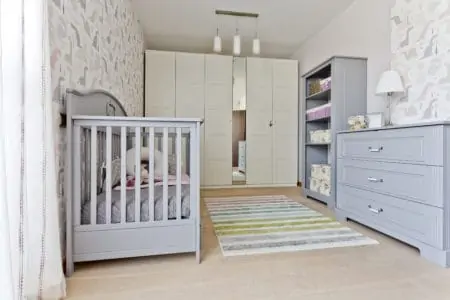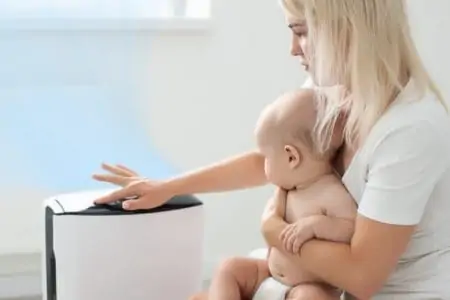Feeling unsure what type of bed is best for your little one? It’s an age-old debate: bassinet or crib?
It’s not a secret that newborns sleep a lot — around 16 to 17 hours a day — so deciding where they spend that time can be a big decision. It needs to be safe, it needs to be comfortable, and it needs to be within your budget.
So how do you choose which one is right for your bundle of joy? We’ll share what we’ve learned through our research and personal experience to help you simplify the decision-making process.
Key Takeaways
- Bassinets are more affordable and portable but have a shorter period of use (4-6 months).
- Cribs are a long-term investment, providing better airflow and sturdiness, but may be less comfortable for some moms.
- The CDC recommends babies sleep in the same room as parents to reduce SIDS risk, making bassinets a good choice for small spaces.
- Cribs come in various types, such as standard, mini, convertible, and portable, offering options for different needs and budgets.
Bassinets vs. Cribs: What’s the Difference?
Choosing between a crib and bassinet can be a tough decision — with all the information and different options out there, it can be pretty overwhelming.
There are a few key differences between the two, and taking a closer look at them may help decide which is right.
1. Cost
Generally speaking, bassinets tend to be more affordable than cribs. This is because they’re made to be used for a shorter period. A good bassinet can cost between $60 and $135 USD.
The average cost of a mid-range crib is between $150 and $450 USD. A crib mattress will cost between $30 and $150 USD.
This makes bassinets a good option for parents who are struggling to afford the upfront cost of baby items and want to put off buying a crib until their baby is older.
2. Period Of Use
Bassinets only last until your baby is 4 to 6 months old, on average, depending on their size and level of mobility (1).
Alternatively, cribs are made to last from the time your baby is a newborn until they’re ready for a larger bed and can be considered more of a long-term investment.
3. Safety Factors
If you choose a bassinet, you need to make sure the bottom is sturdy and solid. Any wheels should have locks on them, so your child’s movements cannot cause it to move or slide.
With cribs, you should ensure the slats are close together so your baby cannot fit their legs or head in between them and get stuck. According to the Consumer Product Safety Commission, crib slats should be no further apart than 2 3/8 inches or 6 centimeters so a baby’s body cannot fit through them. If a soda can fits easily through the crib slats, the spaces between the slats are too wide.
Safety Note
4. Space Requirements
Bassinets are small and often mobile. They don’t take up much room and can easily fit next to your bed in most bedrooms. This makes it easier for you to get to your baby for frequent feedings and diaper changes in those early months.
Cribs are larger and, in most cases, cannot be moved from room to room easily. This means unless your bedroom is spacious, it can be harder for you to have easy access to your baby during the night.
Are you still undecided about whether to crib or a bassinet? There’s no right answer here — every mom has to choose which is best for the baby, budget, and living situation.
Let’s dig further and dissect some pros and cons of each option.
Pros of Bassinets
They Can Reduce SIDS
The Centers for Disease Control and Prevention recommend that babies sleep in the same room as their parents, but in a different bed, to help reduce the risk of SIDS (3). Due to their small size, a bassinet can be a great option to keep your baby close throughout the night.
They Move With You
Many bassinets come with wheels — even if they don’t, they’re lightweight and easy to move. This portability makes them a great option if you want your baby to sleep safely close to you at all times, in every room in the house.
Better New-Mommy Mobility
For new moms, even getting up and moving about can be hard — that’s to say nothing of bending over the rails of a crib to pick up baby! Bassinets are closer to the ground, and have lower sides. This makes it easier to lay baby down and get them out.
Bassinets can be especially beneficial for moms who have back problems, or are recovering from a C-section delivery.
Cons of Bassinets
Need To Be Replaced
Bassinets are not made to last your baby for a long period of time. Most bassinets come with a weight limit of 15 to 20 pounds, and, as we mentioned, work well for babies 4 to 6 months old. Eventually, you will need to move your baby from a bassinet to a crib.
Unless you plan on having more children in the future, it’s a short-term sleeping solution.
Aren’t Really Cost-Effective
While bassinets are a less expensive up-front option, in the long run, they cost you more money because are buying two separate items.
Cost Control
Pros of Cribs
Allow For Air Flow
The spaces between the slats of cribs allow air to flow through, providing a cool and calming environment for your baby. Not only will this make for a happier baby, but good-quality airflow may also reduce your baby’s risk of SIDS by up to 70 percent (4).
Generally Sturdier
Cribs are built to last, and tend to be sturdier than bassinets. This means they’re less likely to fall over while your child is in them. Additionally, children with more mobility will have troubling climbing out of them, protecting them from potential falls.
Cons of Cribs
May Be Uncomfortable For Mom
Moms who have back problems, are recovering from a C-section, or who are on the shorter side may have a hard time with the height of a crib.
These factors could also increase the risk of dropping your baby if you’re not stable when leaning over the railings to lay them down.
Different Types of Cribs
Maybe at this point you’ve made up your mind and settled on purchasing a crib — the questions don’t stop there. There are a wide variety of cribs out on the market in various materials and styles.
Knowing all the ins-and-outs of them can help you choose which is right for you and your little one.
1. Standard Crib
Standard cribs are traditional cribs with four sides that are fixed and do not move. A standard crib stays a crib forever and will not turn into a toddler bed or bigger.
2. Mini Crib
Mini cribs are a great choice because they’re a stable option that will last longer than a bassinet, while still fitting into small bedrooms for parents who want to keep their child close during the night.
The downside is that they won’t last as long as the standard crib. Mini cribs, because of their more diminutive size, will only hold baby until the age of two or so.
Double The Fun
3. Convertible Cribs
Don’t worry, these high-tech baby beds don’t come with a set of keys! Convertible cribs are just as sturdy as standard cribs, and even more cost-effective. They start out as cribs, and eventually can be adapted into toddler beds or full-size beds.
This means you pay one price for a bed that will last you and your baby several years longer than the traditional option.
4. Portable Cribs
Portable cribs are a good option for moms who want something affordable, small, and can be taken with them no matter where they go.
You can get a portable crib that looks like a standard crib on wheels or choose a playard option — an often collapsible enclosure that allows baby a safe sleep and play area.
Portable cribs are great options for traveling and staying in hotels, or for holidays when family or friends may not have baby-friendly sleeping arrangements.
Some playards even come with bassinets and changing table attachments that can be used from birth until your baby is ready to sleep in a bigger bed.
FAQs
What’s Your Dream Baby Bed?
There are many things to consider when choosing a crib or a bassinet for your little bundle of joy. Space, safety, budget, and style are just a few considerations for making this big purchase.
Whether you want to spend less money up front with a bassinet, or invest in a crib for the long term, we hope having more information on the subject will help you (and your baby) rest a little easier!













